
The Great Western Railway 4000 or Star were a class of 4-cylinder 4-6-0 passenger steam locomotives designed by George Jackson Churchward for the Great Western Railway (GWR) in 1906 and introduced from early 1907. The prototype was built as a 4-4-2 Atlantic. They proved to be a successful design which handled the heaviest long-distance express trains, reaching top speeds of 90 mph (145 km/h), and established the design principles for GWR 4-cylinder classes over the next twenty-five years.

The 4073 or Castle Class are 4-6-0 steam locomotives of the Great Western Railway, built between 1923 and 1950. They were designed by the railway's Chief Mechanical Engineer, Charles Collett, for working the company's express passenger trains. They could reach speeds of up to 100 mph (160 km/h).

The Cambrian Railways owned 230 miles (370 km) of track over a large area of mid Wales. The system was an amalgamation of a number of railways that were incorporated in 1864, 1865 and 1904. The Cambrian connected with two larger railways with connections to the northwest of England via the London and North Western Railway, and the Great Western Railway for connections between London and Wales. The Cambrian Railways amalgamated with the Great Western Railway on 1 January 1922 as a result of the Railways Act 1921. The name is continued today in the route known as the Cambrian Line.

The Cholsey and Wallingford Railway is a 2+1⁄2-mile (4 km) long standard gauge heritage railway in the English county of Oxfordshire. It operates along most of the length of the former Wallingford branch of the Great Western Railway (GWR), from Cholsey station, 12 miles (19 km) north of Reading on the Great Western Main Line, to a station on the outskirts of the nearby town of Wallingford.

The Great Western Railway 2900 Class or Saint Class, which was built by the Great Western Railway's Swindon Works, incorporated several series of 2-cylinder passenger steam locomotives designed by George Jackson Churchward and built between 1902 and 1913 with differences in the dimensions. The majority of these were built as 4-6-0 locomotives; but thirteen examples were built as 4-4-2. They proved to be a highly successful class which established the design principles for GWR 2-cylinder classes over the next fifty years, and influenced similar classes on other British railways.
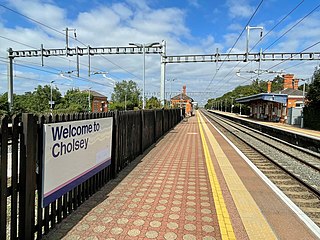
Cholsey railway station serves the village of Cholsey in south Oxfordshire, England, and the nearby town of Wallingford. It is 48 miles 37 chains (78.0 km) down the line from London Paddington and is situated between Goring & Streatley to the east and Didcot Parkway to the west.

Sentinel Waggon Works Ltd was a British company based in Shrewsbury, Shropshire that made steam-powered lorries, railway locomotives, and later, diesel engined lorries, buses and locomotives.

The Great Western Railway (GWR) 4200 Class is a class of 2-8-0T steam locomotives.
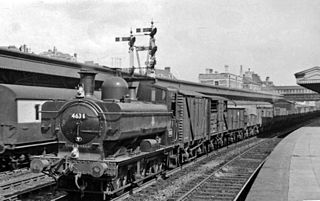
The GWR 5700 Class is a class of 0-6-0PT steam locomotive built by the Great Western Railway (GWR) and British Railways (BR) between 1929 and 1950. With 863 built, they were the most prolific class of the GWR, and one of the most numerous classes of British steam locomotive.
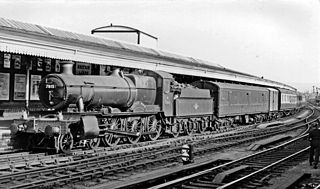
The Great Western Railway (GWR) 7800 Class or Manor Class is a class of 4-6-0 steam locomotive. They were designed as a lighter version of the Grange Class, giving them a wider Route Availability. Like the 'Granges', the 'Manors' used parts from the GWR 4300 Class Moguls but just on the first batch of twenty. Twenty were built between 1938 and 1939, with British Railways adding a further 10 in 1950. They were named after Manors in the area covered by the Great Western Railway. Nine are preserved.

The Great Western Railway (GWR) 2800 Class is a class of Churchward-designed 2-8-0 steam locomotive.

6024 King Edward I is a preserved Great Western Railway (GWR) 6000 Class steam locomotive operated from 1930 to 1962 by the Great Western Railway and latterly British Railways hauling express passenger services.

The Great Western Railway (GWR) steam locomotive No. 4936 Kinlet Hall is a preserved 4-6-0 Hall class locomotive

St Blazey engine shed is located in Par, Cornwall, United Kingdom, although it is named after the adjacent village of St Blazey. It was built in 1874 as the headquarters of the Cornwall Minerals Railway but for many years was a depot of the Great Western Railway. The current depot operator is DB Cargo and the depot TOPS code is BZ.
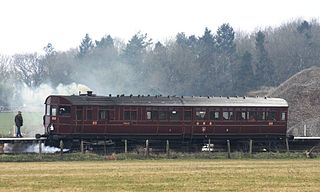
The steam rail motors (SRM) were self-propelled carriages operated by the Great Western Railway in England and Wales from 1903 to 1935. They incorporated a steam locomotive within the body of the carriage.
The North Eastern Railway (NER) Class K classified as Class Y8 by the London and North Eastern Railway (LNER) is a class of 0-4-0T steam locomotives designed for shunting. It was designed by Thomas W. Worsdell and five of these tiny engines were built in 1890. These were numbered 559-63.
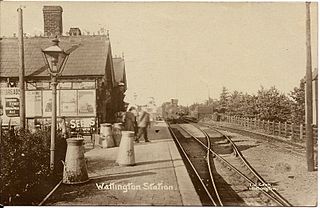
The Watlington and Princes Risborough Railway was an independent English railway company that opened a line between the Oxfordshire towns of Watlington and Chinnor in 1872. The 9 mi (14 km) branch, which connected to the Great Western Railway (GWR) at Princes Risborough, did not make any money and was taken over in 1883 by GWR resulting in its investors sustaining considerable losses.

A steam railcar is a rail vehicle that does not require a locomotive as it contains its own steam engine. The first steam railcar was an experimental unit designed and built in 1847 by James Samuel and William Bridges Adams. In 1848, they made the Fairfield steam carriage that they sold to the Bristol and Exeter Railway, who used it for two years on a branch line.
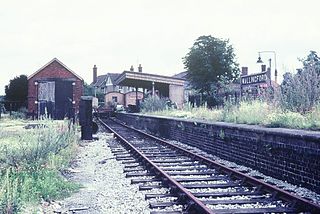
The Wallingford railway branch line was a 2.5 mi (4.0 km) branch line between the market town of Wallingford and the Great Western Railway main line at Wallingford Road in Oxfordshire. The railway, which opened in 1866, was originally planned to go a further 6 mi (9.7 km) to Watlington but this was never completed because of insufficient funds. Instead Watlington was reached by a 9 mi (14 km) line completed by the Watlington and Princes Risborough Railway company in 1872. After the Wallingford branch line opened, it ran regular passenger shuttle services to the GWR mainline for almost a century. It closed to passengers in 1959; the line escaped the Beeching Axe, remaining open for goods services until 1981.


















